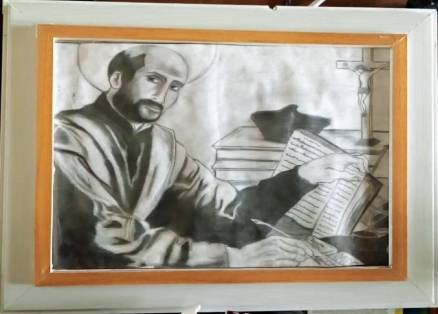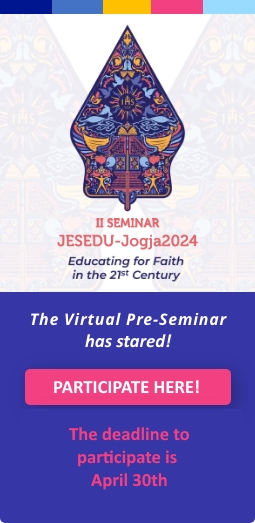St. Ignatius College in Zambia has embarked on an education programme to help learners and staff members internalise the Five (5) C’s of the Ignatian Pedagogical approach to learning. Compassion, Conscience, Competence, Commitment and Consistency are, among other values, earmarked for the whole academic calendar of 2023. The programme has started with Commitment.
To flag off the programme the College put up a skit by pupils who used two pieces of art (a mosaic and drawing) to expound on the Five C’s. This went on well. Both teachers and learners felt animated by the creative way in which the 20-minute presentation was done.
The College espouses these 5 C’s as part of the Jesuit Education Mission to mould young people and form adults who excel in all areas of their human endeavour. These include the arts sciences and technology.
The skit was organised by the Ethos/Chaplaincy Department through Raphael Mwale and Obert Munkombwe, members of staff from the Department of Languages and Fine Arts.
Opening Mass: Launch of 4C’s
In 1973 Fr. Arrupe wrote that, “Today, our prime educational objective must be to form men-for-others; men who will live not for themselves but for God and Christ” (Men for Others, Valencia, 1973). “Men and women for others and with others” is a contemporary expression of the humanism that Jesuit education has embraced from the beginnings. It captures, concisely, the ultimate goal of our educational efforts and our current emphasis in a faith that does justice.
This year as a College, we will be focusing on the 4C’s of Ignatian pedagogy. These 4C’s informs what we do as an institution and makes us unique added by the Jesuit values. These four Cs have also inspired the renewal of Jesuit education in the last two decades. Many of our schools have used the four Cs as a way to explain our vision of educating the whole person. The four Cs capture the true meaning of excellence as explained by Fr. Kolvenbach: “Maximum development of the gifts and capacities with which each person is endowed… for the deployment of [them] in the best possible service of others.” We are forming a global citizen who should be committed to his/her studies, a compassionate person who pays attention to their feelings, a competent person who is a person of magis, a person of conscience who listens to the inner voice and finds God in all things. In the end, all these need consistency from the learners to the educators. Conscience, because in addition to knowing themselves, thanks to developing their ability to internalize and cultivate a spiritual life, they have a consistent knowledge and experience of society and its imbalances. Human Excellence: Competent, professionally speaking, because they have an academic background that exposes them to advances in science and technology. Compassionate, because they are able to open their hearts to be in solidarity with and assume the suffering of others. Committed, because, by being compassionate, they honestly strive toward faith, and through peaceful means, work for social and political transformation of their countries and social structures to achieve justice.” These C’ should not just talk show but be embedded in our hearts, learning and teaching and even parenting as we are a community.
Whenever Parents and Grandparents talk about their younger days, they always mention how their school years formed them and laid the foundation for life ahead. Today’s students are techno-savvy. It is a concern for many parents and teachers today that their mobile phones and the social media overly distract students. Modern technology is not only morally neutral but can be very helpful and beneficial, if used well and in moderation. It is a constant challenge to educate our students in this line. The Society of Jesus, or the Jesuits as they are usually called, want to, through their educational institutions, form men and women with others and for others. Our goal as educators is to form men and women of competence, conscience, and compassion and are committed. Each month this academic year, will be dedicated to a ‘C’ in which everyone in the College should point to as an achievement. January was dedicated to COMMITMENT. Commitment to work and learning for the service of God and others.
Fr Tanaka Cyril Mashiche SJ
College Chaplain
THE SPIRITUAL INSPIRATION FROM THE ART IMAGERY
An artwork can inspire creative and innovative thinking. In itself it transcends aesthetics and encompasses the spiritual realm. From being a value (beauty) on its own, an artwork can be related to spiritual values such as commitment, compassion, conscience, competence and consistency.
Mosaic

This is a piece of Art work, a mosaic, done by Alinane Daka, a 2021 Grade Nine pupil of St. Ignatius College, Lusaka, Zambia, Southern Africa. Alinane had to use a sharp pointed tool to pick glue, a grain of millet, one at a time and place it on a hard board surface for about eight months to arrive at the above artwork. The process of making a mosaic requires patience, consistency and commitment of which in themselves are actually Ignatian values.
Learners need to cultivate these values through such art processes. They should also learn to be inspired by those that engage in such art processes. This should inspire both the artist and the viewer.
Drawing

The St. Ignatius of Loyola drawing invokes in an individual such ideas as all the 5 Ignatian Cs. The desire to meet the demands of the modern world requires competent individual – the entire life story of St. Ignatius of Loyola in itself is a broad manifestation of the five Cs.
PRESENTATIONS OF 4C’s THROUGH ART
Presentation 1. COMMITMENT
“What is Commitment?
Commitment is being dedicated, pledged or bound to a specific course of action in your everyday life.
Commitment is Magis. Magis, as a Jesuit value means striving to do more or better. St Ignatius of Loyola once said, ‘Falling in love with God takes serious commitment and dedication’. An example of a bible verse about commitment is 2 Timothy 4:7. ‘I have fought a good fight, I have finished my course, I have kept the faith’.
In relation to art and design, commitment can be shown by creating an intense piece of artwork such as a mosaic which takes time and patience. To create a mosaic, one has to put in a lot of commitment and dedication. For an artist to create a mosaic, he/she has to pick up either tiny seeds or beads, one by one and place them in an orderly manner patiently to come up with a beautiful and complete piece of artwork.
Commitment is important because it helps you stick to your goals during the good and bad times. Apart from helping you stick to your goals, it makes you more dependable, trustworthy and responsible.
As a Jesuit secondary school all pupils are required to be committed and dedicated towards their school work. Remember, all good things come from commitment.” By Charmaine Mutelo G10
Presentation 2. COMPASSION
“I am compassion. What is compassion? Compassion is an Ignation value that, simply put, means having sympathy and empathy. Sympathy is feeling sorry for someone or showing that you care while empathy is putting yourself in someone else’s shoes or place to understand their feelings and experiences. St. Ignatius of Loyola was a good example of someone with compassion. He was extremely compassionate and religious to the point where he taught others how to be compassionate. All artworks, whether literary, visual or otherwise, evoke feelings of; compassion, hunger, sadness, anger, happiness, desire and more in people. One example of this is a drawing of St. Ignatius of Loyola. Another example is that of a crying child or baby, or a suffering woman. After all, they say, “One art piece speaks over a thousand words.”” By Sibhusisiwe C. G11
Presentation 3. COMPETENCE
“I am competence, the byproduct of the ignatian value ‘commitment’. I have the ability to do things skillfully and efficiently due to the understanding, learning and hard work of certain principles.
In relation to Art and Design, Competence is needed in various places such as the making of a mosaic. When making a mosaic an artist needs to have competence in Knowing that one has to carefully put beads individually to create the desired image. Not only that but the skill of steadiness and the virtue of patience equally play a big role. All these skills and virtues all line up to one thing, competence.” By Biemba Musumali G11

